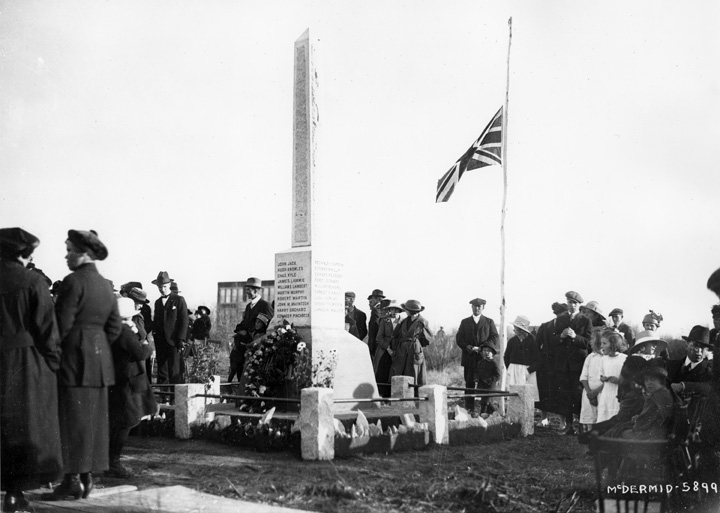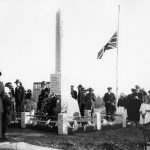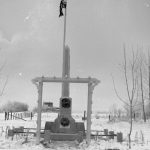Less than two years after the 11th hour of the 11th day of the 11th month of 1918, the first cenotaph in Alberta was dedicated in the Town of Beverly. The trauma of the First World War was still fresh in the minds of the members of the Beverly Veterans’ Association and other servicemen and citizens who gathered at the southwest corner of 118th Avenue and 40th Street on Sunday, October 17, 1920.
A local paper, the Morning Bulletin, reported it was a beautiful autumn afternoon when a monument “erected by the Beverly veterans institute in the memory of their comrades fallen in the war” was unveiled at 3 p.m. Dignitaries at the ceremony included Lieutenant Governor George Brett, Brigadier-General William Griesbach, Edmonton Mayor Joe Clarke and Beverly Mayor Fred Humberstone.
Photos of the dedication show dozens of people dressed in their finery. The weather was obviously chilly because men and women are dressed in overcoats and, as was typical of the period, everyone was wearing a hat.
The story of how Alberta’s first cenotaph came to be started six years earlier, when war broke out in 1914. Beverly was home to barely 1,000 citizens, yet it contributed 170 men to the First World War effort. Twenty-seven of them died in action.
Those who survived returned home with a determination to build a better community and never forget the sacrifices of their fallen comrades. They registered the Beverly Veterans’ Association on April 9, 1920, and quickly set to work raising money to build a memorial.
Thomas R. Dando, the town’s postmaster, mayor for the 1918-1919 term and a veteran himself, stepped up to donate two lots of land. Other local citizens and businesses donated dollars and materials to construct a marble and concrete cenotaph. Just six months later, their work was complete.
Etched above the names of the lost servicemen is a sketch of a heavy artillery canon which also has a local connection. Research by Thomas Court, retired curator of collections at the Royal Alberta Museum, reveals that military gun barrels were cast in a local foundry during the First World War. The foundry may well have been part of the Ottewell Coal Mine located at the east end of the Canadian National Railways bridge on a site that was later home to the Celanese Canada Plant.
Court says the coal was ideal for foundry casting “and its use in the manufacture of gun barrels is testament to this fact. Unfortunately, all that remains to remind us of this industry is the depiction of the armament on the Beverly War Memorial.”
Early photographs of the cenotaph show it standing alone in a windswept field next to a rough road that was then called Alberta Avenue and is now 118th Avenue. It’s easy to forget that, for nearly the first half of the 20th century, life in Beverly was like that in most prairie towns.
Homeowners dug their own wells, the toilet was “out back” and electricity was a luxury. From the beginning right through the 1940s, roads in Beverly were little more than dirt tracks that turned to mud when it rained. Because of the high water table, soil conditions, the cycles of freezing and thawing and mining in the area, the roadways would continuously sink and required frequent attention to remain passable.
After the Second World War, Beverly doubled the size of Memorial Park with the addition of two adjoining lots and the cenotaph moved to a more central location in the park. On Sunday, October 5, 1958, more than 1,000 persons turned out for the re-dedication of the Beverly War Memorial. A plaque bearing the names of five Beverly residents who died in the Second World War was unveiled by Beverly Mayor John Sehn.
The City of Edmonton annexed Beverly in 1961, and the City’s Parks and Recreation Department took over the maintenance of the park and cenotaph. Now over 95 years old, time and climate have taken a toll on the old monument, and it is crumbling. Sidewalks that run through the park around the cenotaph have started to buckle.
Fortunately, the community has rallied to save this local landmark just as celebrations are underway to mark Beverly’s centennial. Local citizens and groups including the Beverly Memorial Cenotaph Committee and Olde Towne Beverly Historical Society have been working for several years to fund repairs. Now the City of Edmonton has agreed to designate the cenotaph and park as a Municipal Historic Resource.
A statement of significance by the City’s heritage planner says character-defining elements on the monument include the Second World War and Korean War plaques and the marble block with date engraved. “Erected by the Beverly Veterans Institute to perpetuate the memory of their comrades who fell in the great war 1914-1919,” it reads.
Under the designation, the City will pay half the $25,000 anticipated cost to restore the monument and half the $78,000 or so required to repair the walkway, fence and base around it. The remainder of the cost will come from local fundraising, and the committee has been working on a comprehensive plan for the site.
For more information on Beverly’s centennial and the plans to restore the cenotaph, among the many other exciting initiatives and activities, visit http://www.beverlyhistory.ca/restoration.html.
Lawrence Herzog © 2014





